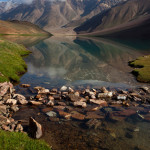 There is much happening in the next six months. I will begin my journeys in a few days in the Himalayas, followed by travels in several parts of North India and Asia. Here is the general plan at this time. Would you have any interesting travel tips in any of these places that I should check out?
There is much happening in the next six months. I will begin my journeys in a few days in the Himalayas, followed by travels in several parts of North India and Asia. Here is the general plan at this time. Would you have any interesting travel tips in any of these places that I should check out?
Spiti Himalayas. I will be in Lahaul & Spiti next week, leading a photography tour for Darter. I will be travelling through magnificent Chandratal Lake, Kaza and several high-altitude villages in Spiti Valley. Besides leading tours for Darter, I am also hoping to do some personal photography projects in the area.
A few short trips. I may be retracing my last year’s visit to the waterfalls of the western ghats after coming back from Spiti. I would also be getting to spend some time in Kochi soon after.

Myanmar and Cambodia. I am excited to be leading this photography tour to Myanmar. My visit to Myanmar last year was an eye-opener about the country. It is well accessible, easy to travel through than what it was a decade ago. And it is welcoming visitors and opening up for more travellers year after year. I am looking forward to going back again, now with a bunch of photography enthusiasts. Travelling Myanmar is a great pleasure.
In the summer of 2002, I decided not to live my life sitting holed up in the city. I made up my mind to take every opportunity to travel and see the beautiful country we have. On the next holiday-slot available, I headed towards the Himalayas, to walk in the wilderness and see the snow peaks. I had never known what high-altitude meant, till then.

My good karma took me to Sikkim, where I saw a new world. I discovered that people can be so friendly that you completely drop your guard and walk around with a wide grin instead. I saw woods so thick that it is impossible to set a foot through them. I saw streams of sweet, frigid waters coming down the mountains and rushing away in a great hurry. I saw wildflowers splattering my path, carpeting the floor and decorating the trees.
“I’d rather take a 12-day trip and spend $100 per night on hotels than a four-day trip where I spend $300 per night on accommodations.” – on Gadling, commenting on a list of Conde Nast Traveller’s ‘best new hotels’, which is full of very expensive hotels.
A statement like this shows how an online magazine or a blog may be able to go extra length in being candid about travel than a print magazine. You will never see such words uttered in a print magazine, where expensive services and products are usually a big source of advertising revenue. If they do, they will probably see their advertisers run away from the next issue, and the magazine closing doors in the subsequent one.
Very often, the mantra of print media is to promote the most expensive – the stuff for which sellers pay to advertise and not necessarily what is best for the traveller. I am often baffled to see ‘Chic clothes for your summer travel, cool things to pack, the list of finest hotels to stay in, and so on..’ in the magazines. The local experience? Of course, the chef at the restaurant in 21st floor of the hotel will dish out some of the finest local dishes. The organized group tour to the local village help you take pictures of people who specially pose for your cameras wearing local clothing..
To be fair for them, the expenses of running a magazine may make publishing such content essential for their survival. And to add further, not all stories tend to have a similar angle. Magazines often do a great deal of research and publish plenty of authentic, original and unheard travel experiences that benefit the travellers. And here in India, a good number of travel magazines, including Outlook Traveller and Lonley Planet, do offer plenty of down to earth and real travel experiences. But it also requires the reader to be alert, who should consciously work to filter the true recommendations against content that is merely a bait for the advertisers.
The above thoughts were scribbled down impulsively when I reflected on Gadling’s story, initially written aggressively and toned down later to look at things analytically than emotionally. I started with an intent to deliver a message about how travel blogs are probably much better off than magazines. But reflecting more on the topic, I realized that blogs do come with their flaws as well. While it is essential for the reader of a travel magazine to analyse the content and see what is good for him/her, perhaps the same applies to blogs too.
A magazine like CNT can afford to work on a list of ‘best new hotels’ by sending their correspondents and stringers to visit the place, perhaps rate them on a set of qualities and parameters, have the editors pour over the reports and eventually produce the list. Not all print magazines may do such extensive work, but there is a good chance that they have done some hard work. But blogs, which too often produce their ‘top 10 lists’ — top 10 honeymoon destinations, top 10 things to do in place X — are more often than not a result of secondary research (hail Google!) or created with limited personal experience (I have seen only place A, B, C in a destination, let me enhance them by calling it the top 3 places to see in the destination). Travel blogs tend to be usually rich in personal experiences, but in many occasions, may not match the quality of the content in a magazine.
Blogs too, especially popular ones that get noticed by a lot of people, may be vulnerable to posting content in favour of a place, service or a product in exchange of some benefits. I must admit here that I have personally accepted invitations to travel at invitees cost and have written about invitees offerings (I must add here that I have limited my stories only to facts and/or personal experiences in all such occasions). I also receive frequent emails where I am offered a payment for a review, post on certain topics or for contextual links within my posts without declaring the sponsor (aka paid news) — something I have never accepted till date. When I was first offered these gigs, I politely wrote back to them on advertising options that I permit on the blog, which never came in favour from the buyers compared to paid posts (now I simply ignore those emails). But blogs may often be tempted by such offers, considering that it takes a lot of time, effort and sometimes even money to regularly maintain a blog.
I began this story in approval of Gadling’s take on print media’s obsession on the expensive, on why blogs may score better in content and why readers may have to filter the content in print media. But as the story progressed and I reflected on all angles to it, I realized that a lot of it may apply to online media as well. What is your experience, and take on this?
 There is much happening in the next six months. I will begin my journeys in a few days in the Himalayas, followed by travels in several parts of North India and Asia. Here is the general plan at this time. Would you have any interesting travel tips in any of these places that I should check out?
There is much happening in the next six months. I will begin my journeys in a few days in the Himalayas, followed by travels in several parts of North India and Asia. Here is the general plan at this time. Would you have any interesting travel tips in any of these places that I should check out?
